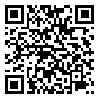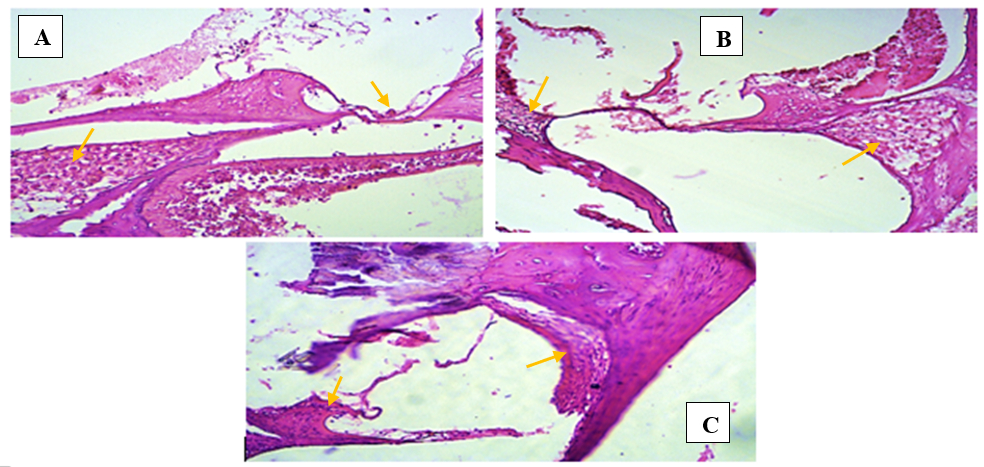Volume 12, Issue 1 (3-2022)
J Health Saf Work 2022, 12(1): 25-39 |
Back to browse issues page
Download citation:
BibTeX | RIS | EndNote | Medlars | ProCite | Reference Manager | RefWorks
Send citation to:



BibTeX | RIS | EndNote | Medlars | ProCite | Reference Manager | RefWorks
Send citation to:
Khadem M, Kazemi Rad E, Monazzam Esmaeilpoor M R, Mirzaei Hotkani M, Mozaffari S, Abbasi Garmaroudi A. The Evaluation of GJB2 Gene Expression in the Cochlear Tissue Exposed to White Noise. J Health Saf Work 2022; 12 (1) :25-39
URL: http://jhsw.tums.ac.ir/article-1-6631-en.html
URL: http://jhsw.tums.ac.ir/article-1-6631-en.html
Monireh Khadem1 
 , Elham Kazemi Rad2
, Elham Kazemi Rad2 
 , Mohammad Reza Monazzam Esmaeilpoor1
, Mohammad Reza Monazzam Esmaeilpoor1 
 , Maryam Mirzaei Hotkani1
, Maryam Mirzaei Hotkani1 
 , Sajjad Mozaffari1
, Sajjad Mozaffari1 
 , Amir Abbasi Garmaroudi *
, Amir Abbasi Garmaroudi * 
 3
3

 , Elham Kazemi Rad2
, Elham Kazemi Rad2 
 , Mohammad Reza Monazzam Esmaeilpoor1
, Mohammad Reza Monazzam Esmaeilpoor1 
 , Maryam Mirzaei Hotkani1
, Maryam Mirzaei Hotkani1 
 , Sajjad Mozaffari1
, Sajjad Mozaffari1 
 , Amir Abbasi Garmaroudi *
, Amir Abbasi Garmaroudi * 
 3
3
1- Department of Occupational Health Engineering, School of Public Health, Tehran University of Medical Sciences, Tehran, Iran
2- Department of Medical Parasitology and Mycology, School of Public Health, Tehran University of Medical Sciences, Tehran, Iran
3- Department of Occupational Health Engineering, School of Public Health, Tehran University of Medical Sciences, Tehran, Iran ,a-garmaroudi@alumnus.tums.ac.ir
2- Department of Medical Parasitology and Mycology, School of Public Health, Tehran University of Medical Sciences, Tehran, Iran
3- Department of Occupational Health Engineering, School of Public Health, Tehran University of Medical Sciences, Tehran, Iran ,
Abstract: (1908 Views)
Introduction: One of the most important complications of exposure to noises is changes in the gene expression patterns. Irreversible damage to the inner ear, such as noise-induced hearing loss (NIHL), is caused by tissue damage and changes in the gene expressions in the auditory system. Changes in the GJB2 gene expression pattern lead to autosomal deafness at different loci. The present study aims to evaluate the GJB2 gene expression in cochlear tissue exposed to white noise.
Material and Methods: In this study, ten male Westar rats were divided into two experimental (W1, W2) groups of six rats and a control (normal) group of four rats. Two experimental groups were exposed to constant white noise in the frequency range of 100-20000 Hz and the sound pressure level of 118-120 dB. In order to study the histology and gene expression, after a cochlea biopsy, the histological tests, RNA extraction, cDNA synthesis, and qRT-PCR analysis were performed.
Results: The results showed that the transcript level of GJB2 was significantly decreased in both experimental groups W1 and W2 by 0.02 and 0.12-fold, respectively (p <0.05). Also, the results of the histological study showed that cochlear tissue was more seriously damaged in the W1 group than W2.
Conclusion: It can be concluded that a significant reduction in the GJB2 gene expression and irrevocable damage to auditory nerve ganglion and Reissner membrane (vestibular membrane) caused changes in the gene expression patterns in cochlear tissue and developed the risk of non-syndromic sensorineural hearing.
Material and Methods: In this study, ten male Westar rats were divided into two experimental (W1, W2) groups of six rats and a control (normal) group of four rats. Two experimental groups were exposed to constant white noise in the frequency range of 100-20000 Hz and the sound pressure level of 118-120 dB. In order to study the histology and gene expression, after a cochlea biopsy, the histological tests, RNA extraction, cDNA synthesis, and qRT-PCR analysis were performed.
Results: The results showed that the transcript level of GJB2 was significantly decreased in both experimental groups W1 and W2 by 0.02 and 0.12-fold, respectively (p <0.05). Also, the results of the histological study showed that cochlear tissue was more seriously damaged in the W1 group than W2.
Conclusion: It can be concluded that a significant reduction in the GJB2 gene expression and irrevocable damage to auditory nerve ganglion and Reissner membrane (vestibular membrane) caused changes in the gene expression patterns in cochlear tissue and developed the risk of non-syndromic sensorineural hearing.
Type of Study: Research |
Received: 2022/03/6 | Accepted: 2022/03/30 | Published: 2022/03/30
Received: 2022/03/6 | Accepted: 2022/03/30 | Published: 2022/03/30
Send email to the article author
| Rights and permissions | |
 |
This work is licensed under a Creative Commons Attribution-NonCommercial 4.0 International License. |





